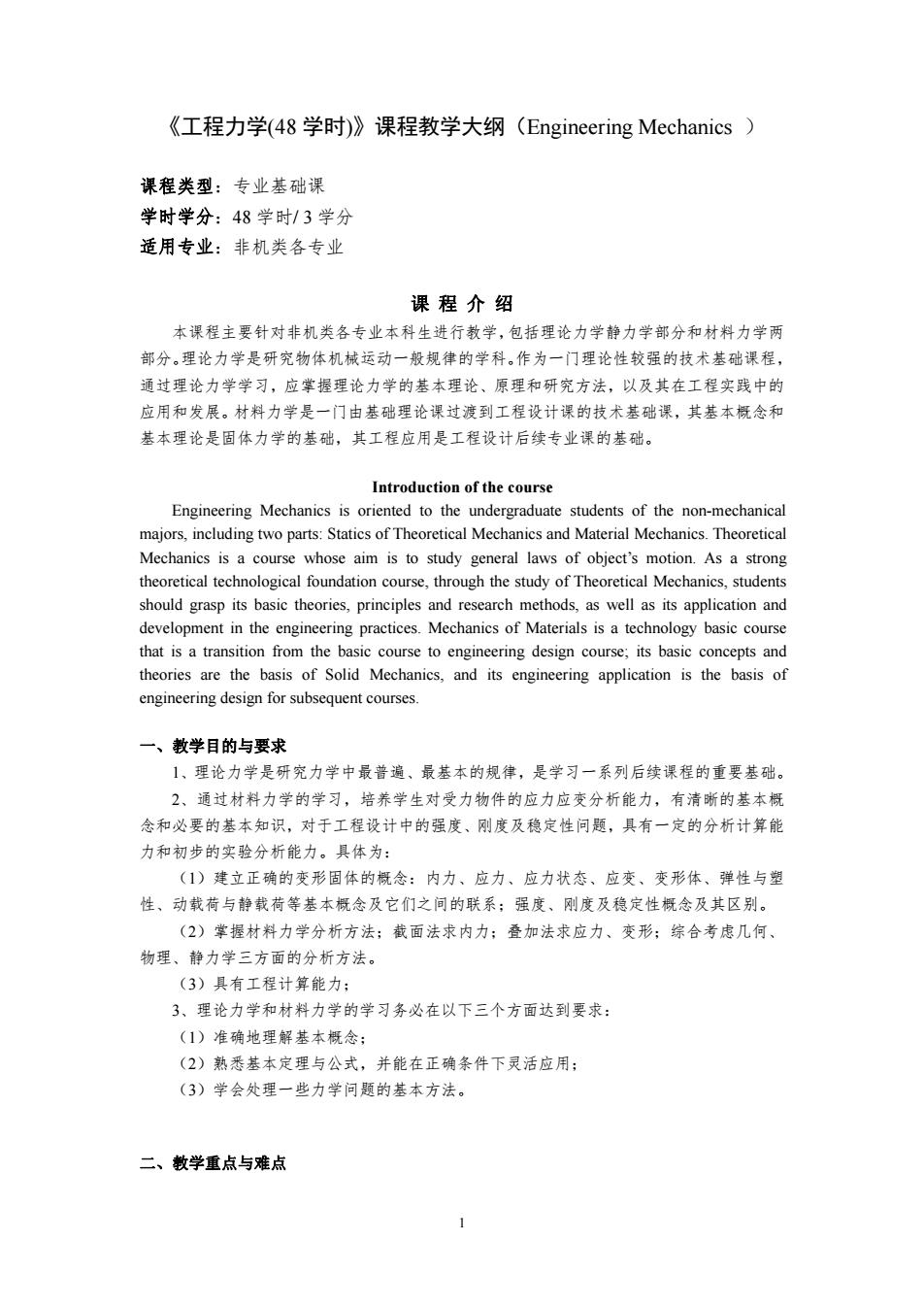正在加载图片...

《工程力学(48学时)》课程教学大纲(Engineering Mechanics) 课程类型:专业基础课 学时学分:48学时/3学分 适用专业:非机类各专业 课程介绍 本课程主要针对非机类各专业本科生进行教学,包括理论力学静力学部分和材料力学两 部分。理论力学是研究物体机械运动一殼规律的学科。作为一门理论性较强的技术基础课程, 通过理论力学学习,应掌握理论力学的基本理论、原理和研究方法,以及其在工程实践中的 应用和发展。材料力学是一门由基础理论课过渡到工程设计课的技术基础课,其基本概念和 基本理论是固体力学的基础,其工程应用是工程设计后续专业误的基础。 Introduction of the course Engineering Mechanics is oriented to the undergraduate students of the non-mechanical majors,including two parts:Statics of Theoretical Mechanics and Material Mechanics.Theoretical Mechanics is a course whose aim is to study general laws of obiect's motion.As a strong heoretical technological foundation course through the study of Theoretical mechanics students should grasp its basic theor and rese well as its application development in the g practices. Mechanics o terials gy basic from the b toengineering design its basic conepts and theories are the basis of Solid Mechanics,and its engineering application is the basis of engineering design for subsequent courses. 一、教学目的与要求 1、理论力学是研究力学中最普通、最基本的规律,是学习一系列后续课程的重要基础, 2、通过材料力学的学习,培养学生对受力物件的应力应变分析能力,有清晰的基本 念和必要的基本知识,对于工程设计中的强度、刚度及稳定性问题,具有一定的分析计算能 力和初步的实验分析能力。具体为: (】)球立正确的变形固体的概念:内力、应力、应力状态,应变、变形体、弹性与翔 性、动载荷与静荷等基本概念及它们之间的联系:强度、刚度及稳定性概念及其区别。 (2)掌握材料力学分析方法:截面法求内力:叠加法求应力、变形:综合考虑几何 物理、静力学三方面的分析方法 (3)具有工程计算能力 3,理论力学和材料力学的学习务必在以下三个方面达到要求: (1)准确地理解基本概念: (2)熟悉基本定理与公式,并能在正确条件下灵活应用: (3)学会处理一些力学问题的基本方法。 二、教学重点与难点 1 《工程力学(48 学时)》课程教学大纲(Engineering Mechanics ) 课程类型:专业基础课 学时学分:48 学时/ 3 学分 适用专业:非机类各专业 课 程 介 绍 本课程主要针对非机类各专业本科生进行教学,包括理论力学静力学部分和材料力学两 部分。理论力学是研究物体机械运动一般规律的学科。作为一门理论性较强的技术基础课程, 通过理论力学学习,应掌握理论力学的基本理论、原理和研究方法,以及其在工程实践中的 应用和发展。材料力学是一门由基础理论课过渡到工程设计课的技术基础课,其基本概念和 基本理论是固体力学的基础,其工程应用是工程设计后续专业课的基础。 Introduction of the course Engineering Mechanics is oriented to the undergraduate students of the non-mechanical majors, including two parts: Statics of Theoretical Mechanics and Material Mechanics. Theoretical Mechanics is a course whose aim is to study general laws of object’s motion. As a strong theoretical technological foundation course, through the study of Theoretical Mechanics, students should grasp its basic theories, principles and research methods, as well as its application and development in the engineering practices. Mechanics of Materials is a technology basic course that is a transition from the basic course to engineering design course; its basic concepts and theories are the basis of Solid Mechanics, and its engineering application is the basis of engineering design for subsequent courses. 一、教学目的与要求 1、理论力学是研究力学中最普遍、最基本的规律,是学习一系列后续课程的重要基础。 2、通过材料力学的学习,培养学生对受力物件的应力应变分析能力,有清晰的基本概 念和必要的基本知识,对于工程设计中的强度、刚度及稳定性问题,具有一定的分析计算能 力和初步的实验分析能力。具体为: (1)建立正确的变形固体的概念:内力、应力、应力状态、应变、变形体、弹性与塑 性、动载荷与静载荷等基本概念及它们之间的联系;强度、刚度及稳定性概念及其区别。 (2)掌握材料力学分析方法;截面法求内力;叠加法求应力、变形;综合考虑几何、 物理、静力学三方面的分析方法。 (3)具有工程计算能力; 3、理论力学和材料力学的学习务必在以下三个方面达到要求: (1)准确地理解基本概念; (2)熟悉基本定理与公式,并能在正确条件下灵活应用; (3)学会处理一些力学问题的基本方法。 二、教学重点与难点